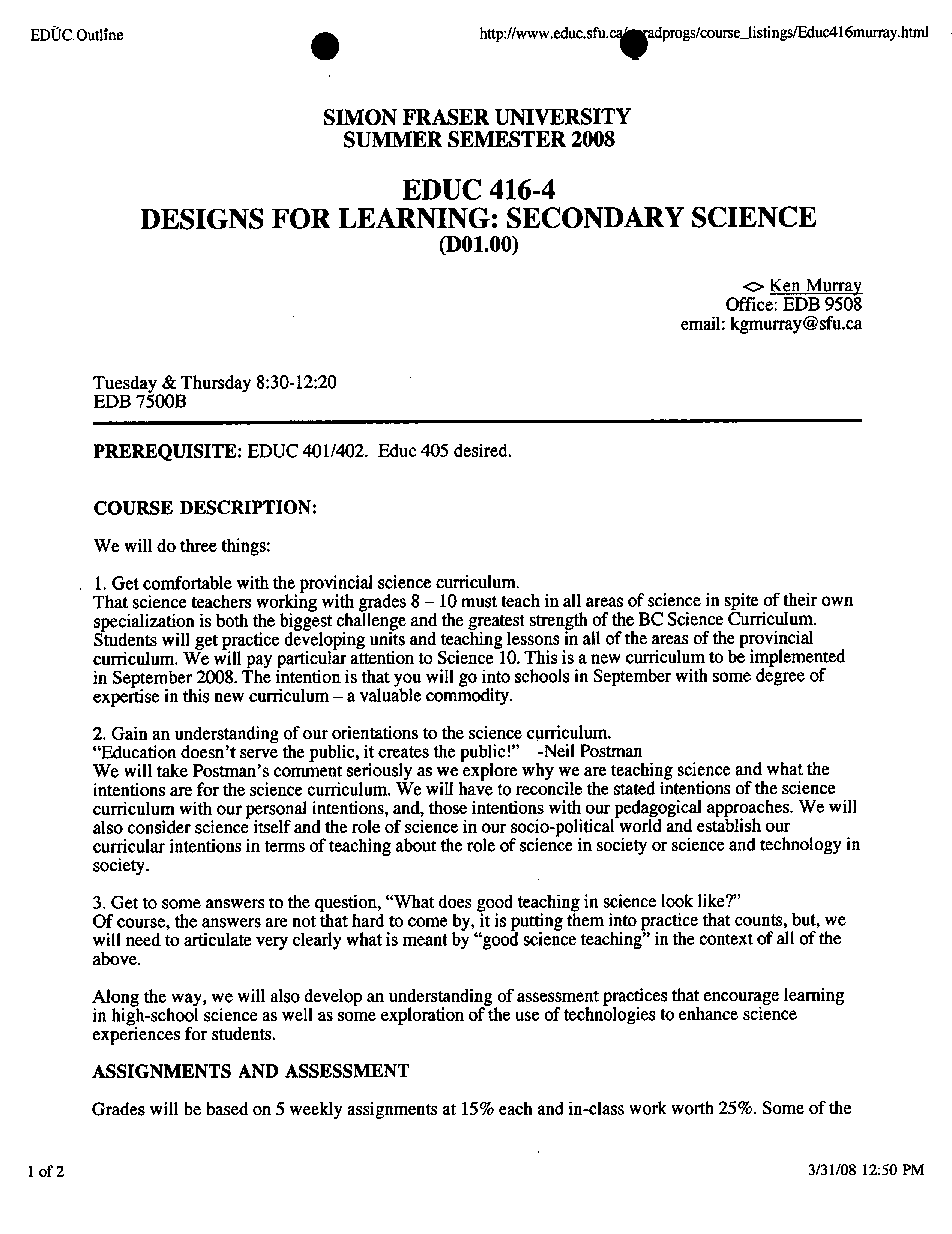EDUC. Outffne ?
http://www.educ.sfu.Cr
progs/course^—listings/Educ4l6murray.htmI
SIMON FRASER UNIVERSITY?
SUMMER SEMESTER 2008
EDUC 416-4
DESIGNS FOR LEARNING: SECONDARY SCIENCE
?
(D01.00)
0 Ken Murray ?
Office: EDB 9508 ?
email: kgmurray@sfu.ca
Tuesday & Thursday 8:30-12:20
EDB 7500B
PREREQUISITE:
EDUC
401/402.
Educ
405 desired.
COURSE DESCRIPTION:
We will do three things:
1.
Get comfortable with the provincial science curriculum.
That science teachers working with grades 8 - 10 must teach in all areas of science in spite of their own
specialization is both the biggest challenge and the greatest strength of the BC Science Curriculum.
Students will get practice developing units and teaching lessons in all of the areas of the provincial
curriculum. We will pay particular attention to Science 10. This is a new curriculum to be implemented
in September 2008. The intention is that you will go into schools in September with some degree of
expertise in this new curriculum - a valuable commodity.
2.
Gain an understanding of our orientations to the science curriculum.
"Education doesn't serve the public, it creates the public!" -Neil Postman
We will take Postman's comment seriously as we explore why we are teaching science and what the
intentions are for the science curriculum. We will have to reconcile the stated intentions of the science
curriculum with our personal intentions, and, those intentions with our pedagogical approaches. We will
also consider science itself and the role of science in our socio-political world and establish our
curricular intentions in terms of teaching about the role of science in society or science and technology in
society.
3.
Get to some answers to the question, "What does good teaching in science look like?"
Of course, the answers are not that hard to come by, it is putting them into practice that counts, but, we
will need to articulate very clearly what is meant by "good science teaching" in the context of all of the
above.
Along the way, we will also develop an understanding of assessment practices that encourage learning
in high-school science as well as some exploration of the use of technologies to enhance science
experiences for students.
ASSIGNMENTS AND ASSESSMENT
Grades will be based on
5
weekly assignments at
15%
each and in-class work worth
25%.
Some of the
1of 2 ?
3/31/08 12:50 PM
http://www.educ.sfu .
?
dprogs/course_listingslEduc4l 6murray.html
weekly assignments will overlap with in-class work, effectively making the actual in-class component
greater than
25%.
Criteria for assessment will be developed in the first two classes and will be directed
toward the intentions of the course as outlined above, especially the part about what good science
teaching looks like.
READINGS
Most of the readings such as government curriculum documents and other articles will be available
on-line. We will use WebCF to post links and articles as well as assignment background and details.
Some information and print articles will be provided in class but we will try to avoid having an extra
photocopy fee ($10).
Students in all Faculty of
Education courses are encouraged to review policies pertaining to
academic integrity available on the Undergraduate Programs websie:
2of2 ?
3/31/08 12:50 PM


